

Clinical judgments, not algorithms, are key to patient safety—an essay by David Healy and Dee Mangin. When it comes to detecting harms related to drugs, clinicians’ and patients’ judgment trumps trials, say David Healy and Dee Mangin.
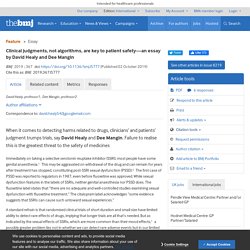
Failure to realise this is the greatest threat to the safety of medicines Immediately on taking a selective serotonin reuptake inhibitor (SSRI), most people have some genital anaesthesia.1 This may be aggravated on withdrawal of the drug and can remain for years after treatment has stopped, constituting post-SSRI sexual dysfunction (PSSD).2 The first case of PSSD was reported to regulators in 1987, even before fluoxetine was approved.
While sexual dysfunction features in the labels of SSRIs, neither genital anaesthesia nor PSSD does. The fluoxetine label states that “there are no adequate and well-controlled studies examining sexual dysfunction with fluoxetine treatment.” The citalopram label acknowledges “some evidence suggests that SSRIs can cause such untoward sexual experiences.” SGEM#272: Take the Money and Run without Getting at CT. Podcast: Play in new window | Download Subscribe: Android | Date: October 22nd, 2019 Reference: Iyengar R et al.

The Effect of Financial Incentives on Patient Decisions to Undergo Low-value Head Computed Tomography Scans. AEM October 2019. Guest Skeptic: Dr. Jamanetwork. Key Points Question Is care for older adults with multiple chronic conditions that is aligned with their health priorities associated with improved patient-reported outcomes and reduced unwanted care?

Findings This nonrandomized clinical trial of 366 adults 65 years or older with multiple chronic conditions found that, although there was no difference in perception of whether their care was goal-directed or coordinated, participants receiving patient priorities care vs usual care reported a greater reduction in treatment burden, and their health records reflected more medications stopped and fewer self-management tasks and diagnostic tests added. Meaning This study’s findings suggest that aligning care with patients’ priorities may improve outcomes for patients with multiple chronic conditions. Mayo Clinic Shared Decision Making National Resource Center. There are many situations in which patients and clinicians need to and are making decisions together, arguably these are all instances of Shared Decision Making (SDM).
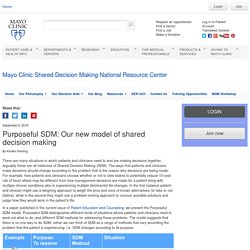
The ways that patients and clinicians make decisions should change according to the problem that is the reason why decisions are being made. For example, how patients and clinicians choose whether or not to take statins to potentially reduce 10-year risk of heart attack may be different from how management decisions are made for a patient living with multiple chronic conditions who is experiencing multiple detrimental life changes. In the first instance patient and clinician might use a weighing approach to weigh the pros and cons of known alternatives (to take or not statins), while in the second they might use a problem-solving approach to uncover possible solutions and judge how they would work in the patient’s life. Authors: Ian G. Hargraves, Victor M. Purposeful SDM - Schema from KER Unit. Decision Aids for Prostate Cancer Screening Choice: A Systematic Review and Meta-analysis. Key Points Question What is the association of decision aids vs usual care with shared decision-making in men deciding whether to undergo prostate cancer screening?

Findings This systematic review and meta-analysis of 19 randomized clinical trials comparing decision aids for prostate cancer screening (12 781 men) found that decision aids are probably associated with a small reduction in decisional conflict and are possibly associated with an increase in knowledge. Decision aids are possibly not associated with whether physicians and patients discuss prostate cancer screening and are possibly not associated with actual screening decisions. Meaning Randomized clinical trials have failed to provide compelling evidence for the use of decision aids for men contemplating prostate cancer screening that have, up to now, undergone rigorous testing to determine their outcome.
Objective To estimate the association of decision aids with decisional outcomes in prostate cancer screening. Participation of Very Old Adults in Healthcare Decisions. What’s More Dangerous, Your Aspirin Or Your Car? Thinking Rationally About Drug Risks (And Benefits) E nsuring the safety of drugs has been a primary regulatory goal in the United States since the Food, Drug, and Cosmetic Act was passed in 1938.
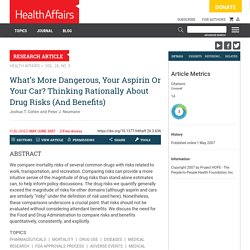
Nonetheless, concerns about the safety of FDA-approved drugs have persisted; they have recently attracted extensive media attention. In 2004, Merck and Company withdrew its nonsteroidal anti-inflammatory drug Vioxx (rofecoxib), after several years of controversy, when further data indicated that it increases the risk of fatal cardiovascular events. A May 2006 Harris Interactive poll found that nearly three in five U.S. adults have a negative view of the FDA’s ability to ensure drug safety and efficacy. 3 Curt Furberg and colleagues have suggested that the “FDA has been slow compared with the action of European regulatory agencies in some recent cases (e.g., problems involving troglitazone, trovafloxacin, and tolcapone).” 4 Congress has held hearings and considered several bills that would increase the regulatory emphasis on drug safety. 5.
Chest Pain Choice tool decreases health care utilization. Too much testing: Are patients to blame? Eliciting patient values and preferences to inform shared decision making in preventive screening. Addressing overmedicalisation: Effective doctor-patient communication, talking about what’s truly needed. A likely scenario: A patient walks into the clinic complaining of a back pain and leaves with a prescription for certain medication and sometimes, a referral for MRI imaging.

Chances are, the back pain could have been a result of poor sleeping position, prolonged bad posture at work, or other lifestyle issues that might not have been properly communicated or addressed during consultation—which an MRI imaging also would not have benefitted. Truth is, back pain is not the only condition that is often “overmedicalised”. A research letter published in the Journal of American Medical Association (JAMA) highlighted that neuroimaging due to headaches, which contributes to approximately USD1 billion in annual costs—is increasing over time.
This is despite published guidelines discouraging neuroimaging for simple headaches. In the accompanying Editor’s Note, Mitchell H. Status Iatrogenicus: The Number Needed Not To Treat To Harm (NNNTTTH): A Heuristic for Evaluating Trade-offs in Medical Decisions. A frequent conundrum of decision making that arises in medicine is when there is a generally indicated therapy, say, anticoagulation for atrial fibrillation, that poses unique risks in a particular patient.
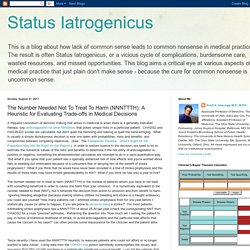
CHADS2 and HAS-BLED scores are calculated, but don't quiet the hemming and hawing or quell the hand-wringing. What is usually a simple dichotomous decision is now one laden with probabilities, risks and benefits, and compromise between competing objectives. (See: The Therapeutic Paradox: What's Right for the Population May Not Be Right for the Patient.) In order to restore nuance to the decision, we need to try to estimate the numerical values of the risks and benefits to determine if the net utility of anticoagulation is positive or negative, something the aforementioned calculators are intended to do in a semi-quantitative way. Shared Decision Making and Improving Health Care. Shared Decision Making and Communication. When asked if they would like to be involved in decisions about their health care, approximately 9 of 10 US patients say they want to know all of their options.
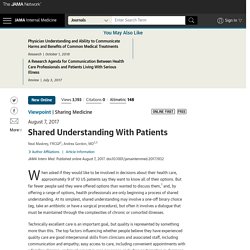
But far fewer people said they were offered options than wanted to discuss them,1 and, by offering a range of options, health professionals are only beginning a process of shared understanding. At its simplest, shared understanding may involve a one-off binary choice (eg, take an antibiotic or have a surgical procedure), but often it involves a dialogue that must be maintained through the complexities of chronic or comorbid illnesses.
Technically excellent care is an important goal, but quality is represented by something more than this. Shared understanding is more than information. Decision aids for patients considering total joint replacement: a cost-effectiveness analysis alongside a randomised controlled trial - ScienceDirect. Background Shared decision-making (SDM) is a key priority to improve patient-centred care, and can play an important role in helping patients decide whether to undergo total joint arthroplasty (TJA).
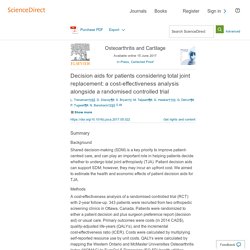
Patient decision aids can support SDM; however, they may incur an upfront cost. We aimed to estimate the health and economic effects of patient decision aids for TJA. Methods A cost-effectiveness analysis of a randomised controlled trial (RCT) with 2-year follow-up. 343 patients were recruited from two orthopedic screening clinics in Ottawa, Canada. Results The sample comprised 167 intervention and 167 control group patients.
Conclusion. Jamanetwork. Question Compared with usual care, what is the effect of an intervention combining a colorectal cancer (CRC) screening decision aid and patient navigation on CRC screening completion in a diverse, vulnerable primary care population? Findings In this randomized clinical trial that included 265 patients, the rate of CRC screening completion at 6 months was greater in the intervention arm (68%) than in the control arm (27%), a significant difference. Meaning Given the substantial effect on screening, efforts to understand how this kind of intervention can be more broadly implemented are warranted. Importance Colorectal cancer (CRC) screening is underused, especially among vulnerable populations.
Primum Non Nocere: is shared decision-making the answer? Clinicians' Expectations of the Benefits and Harms of Treatments, Screening, and Tests: A Systematic Review. The risk of death by age, sex, and smoking status in the United States: putting health risks in context. What’s More Dangerous, Your Aspirin Or Your Car? Thinking Rationally About Drug Risks (And Benefits) Comparing Traditional and Participatory Dissemination of a Shared Decision Making Intervention. Project Information Principal Investigator Hazel Tapp, PhD, BSc Project End Date Click Here! Includes the Research Project Period and may be subject to modification to allow other research-related activities such as peer review. Organization Carolinas Medical Center Project Start Date May 2013 Funding Announcement. Picture this: a new way of seeing risk. Interventions for improving the adoption of shared decision making by healthcare professionals. MMS: Error.
Shared decision making in patients with low risk chest pain: prospective randomized pragmatic trial. Erik P Hess, associate professor1 2 3, Judd E Hollander, professor4, Jason T Schaffer, assistant professor5, Jeffrey A Kline, professor5, Carlos A Torres6, Deborah B Diercks, professor7, Russell Jones, assistant professor8, Kelly P Owen, assistant professor8, Zachary F Meisel, assistant professor9, Michel Demers, patient adviser10, Annie Leblanc, research collaborator and caregiver adviser2 11, Nilay D Shah, associate professor11, Jonathan Inselman, statistical programmer analyst3, Jeph Herrin, biostatistician13, Ana Castaneda-Guarderas, resident1 2 14, Victor M Montori, professor2 15Author affiliationsCorrespondence to: E P Hess hess.erik@mayo.eduAccepted 3 November 2016. Shared Decision Making: A Model for Clinical Practice.
To accomplish SDM, we propose a three-step model for clinical practice (see Fig. 1). We want to emphasize that this is a simplified model that illustrates the process of moving from initial to informed preferences. We acknowledge that this process also has psychological, social and emotional factors that will influence this deliberation space and that will need to be managed by an effective clinician-patient dialogue, seeking what Epstein has termed a ‘shared mind’.33 However, accepting these requirements, we aim for parsimony.
We describe three key steps of SDM for clinical practice, namely: choice talk, option talk and decision talk, where the clinician supports deliberation throughout the process (Fig. 1 and Boxes 1, 2 and 3). Choice talk refers to the step of making sure that patients know that reasonable options are available. Measurement challenges in shared decision making: putting the ‘patient’ in patient-reported measures - Barr - 2015 - Health Expectations. Helping Patients Decide: Ten Steps to Better Risk Communication. Effective reassurance of patients. Rammya Mathew and James McGowan: The role of shared decision making in a value based NHS. Last month a controversial proposal was made by Vale of York clinical commissioning group (CCG) to deny obese patients access to elective surgery for up to a year.
The headlines were alarming and the approach felt wrong. The CCG defended its position by saying that it was “the best way of achieving maximum value from the limited resource available.” The suggestion is now under review in the wake of the outcry it caused, but is this a sign of the kind of care rationing we will increasingly start to see? Physician Understanding and Ability to Communicate Harms and Benefits of Common Medical Treatments. Twelve myths about shared decision making - Patient Education and Counseling. Notwithstanding these developments, arguments against the scaling up of shared decision making across the healthcare continuum abound. Talking to the Doctor About Treatment Harms. Whether preparing to undergo sensitive surgery or facing the prospect of spending a night in the hospital, patients often lack a critical piece of information to make an informed medical decision.
“Risks are not being adequately discussed by physicians with their patients,” says David Magnus, director of the Stanford Center of Biomedical Ethics in Stanford, California. Research shows doctors frequently talk little or not at all about how treatment could possibly harm patients or even lead to their death, whether they’re being admitted to the hospital for chest pain; undergoing a procedure to get an implantable device used to prevent sudden death from certain heart conditions, such as ventricular tachycardia; having prostate removal surgery to treat cancer; or discussing general care with a primary care physician. “The moment of communication we were studying, was a moment where the decision to admit a patient to the hospital had just been made,” says lead study author Dr. Margaret McCartney: The conflict of choice. Shared decision making is the pivot on which modern medical ethics rest.
Doctor appraises patient of the choices available. Doctor supplies evidence and lays out the pros and cons. A Comparative Effectiveness Trial of Alternate Formats for Presenting Benefits and Harms Information for Low-Value Screening Services: A Randomized Clinical Trial. A Comparative Effectiveness Trial of Alternate Formats for Presenting Benefits and Harms Information for Low-Value Screening Services: A Randomized Clinical Trial. Corresponding Author: Stacey L. Sheridan, MD, MPH, University of North Carolina at Chapel Hill, Division of General Medicine and Epidemiology, 5039 Old Clinic Building, CB 7110, Chapel Hill, NC 27599 (Stacey_sheridan@med.unc.edu). Accepted for Publication: October 29, 2015. Patient Decision Aids for Discouraging Low-Value Health Care Procedures: Null Findings and Lessons Learned. Doctors and patients making decisions together reduces antibiotic prescribing: an important part of the fight against antibiotic resistance.
A new Cochrane Review published today shows that when doctors and patients are encouraged to discuss the need for prescribing antibiotics for acute respiratory infections jointly, fewer are prescribed. This may be useful in the fight against antibiotic resistance. Patients’ Expectations of the Benefits and Harms of Treatments, Screening, and Tests: A Systematic Review. Using Option Grids: steps toward shared decision-making for neonatal circumcision - Patient Education and Counseling. Fig. 1. Shared decision making: what do clinicians need to know and why should they bother? Getting to “No” Use of a decision aid including information on overdetection to support informed choice about breast cancer screening: a randomised controlled trial. Patients, Providers, And Systems Need To Acquire A Specific Set Of Competencies To Achieve Truly Patient-Centered Care.
The Value of Sharing Treatment Decision Making With Patients: Expecting Too Much? Authoritarian Physicians And Patients' Fear Of Being Labeled 'Difficult' Among Key Obstacles To Shared Decision Making. Decision aids for people facing health treatment or screening decisions - The Cochrane Library - Stacey. Prenatal Genetic Testing:, Effect of Enhanced Information, Values Clarification, and Removal of Financial Barriers on Use of: A Randomized Clinical Trial. Informed Decision Making for Percutaneous Coronary Intervention for Stable Coronary Disease. Editorials: Introducing Medicine by the Numbers: A Collaboration of The NNT Group and AFP.
Medicine by the Numbers: Ondansetron for Gastroenteritis in Children and Adolescents. Good Stewardship - Provider Version - 640x360_h264_1.mp4. The Doctor Game: Do you really need a CT scan? Patients Clueless About Treatment Risks; Docs Little Help.